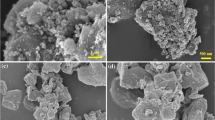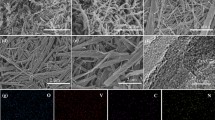Abstract
The discontinuity of new types of clean energy, such as wind power and solar cells, has promoted the development of large-scale energy storage systems (EES). Rechargeable aqueous zinc-ion batteries (ZIBs) have received extensive attention due to their inherent safety and low cost. At this stage, the performance of ZIBs is still limited by cathode materials. In this work, we have constructed a ZIBs cathode material-V2O3@N–C, through surface coating and N atom doping. The N-doped carbon coating endows V2O3@N–C with excellent structural stability and enhances its electrical conductivity. As a result, V2O3@N–C cathode delivers exceptional reversible of Zn2+ intercalation/deintercalation. The fabricated Zn/V2O3@N–C batteries exhibit high capacity of 274.6 mAh·g−1 at 5 A·g−1 and excellent capacity retention of 94% after 2000 cycles. The reversible intercalation/deintercalation of Zn2+ in the V2O3@N–C cathode is proved by ex-situ testing methods. It is believed that this work should inject new vitality into the development of ZIBs cathode.
Graphical abstract

摘要
风能, 太阳能等新型清洁能源的不连续性, 促进了大规模储能系统的发展。水系锌离子电池因其固有的安全性和低成本而受到广泛关注。 现阶段, 水系锌离子电池的性能仍然受到正极材料的限制。 在本工作中, 我们通过表面涂层和氮原子掺杂, 构建了水系锌离子电池正极材料V2O3@N-C。 氮掺杂碳涂层使V2O3@N-C具有良好的结构稳定性, 提高了其导电性。 因此, V2O3@N-C正极表现出优异的锌离子脱/嵌可逆性。 制备的Zn/V2O3@N-C电池在5 A·g-1下展现出了274.6 mAh·g-1的高容量, 2000次循环后容量保持率达94%。 用非原位测试方法证实了锌离子在V2O3@N-C正极中可逆的脱/嵌现象。 我们相信这项工作将为水系锌离子电池正极的发展注入新的活力。





Similar content being viewed by others
References
Dunn B, Kamath H, Tarascon JM. Electrical energy storage for the grid: a battery of choices. Science. 2011;334(6058):928.
Larcher D, Tarascon JM. Towards greener and more sustainable batteries for electrical energy storage. Nat Chem. 2015;7(1):19.
Gao XL, Liu XH, Xie WL, Zhang LS, Yang SC. Multiscale observation of Li plating for lithium-ion batteries. Rare Met. 2021;40(11):3038.
Ruan TT, Wang B, Yang YB, Zhang X, Song RS, Ning Y, Wang ZB, Yu HJ, Zhou Y, Wang DL, Liu HK, Dou SX. Interfacial and electronic modulation via localized sulfurization for boosting lithium storage kinetics. Adv Mater. 2020;32(17):e2000151.
Pu KC, Zhang X, Qu XL, Hu JJ, Li HW, Gao MX, Pan HG, Liu YF. Recently developed strategies to restrain dendrite growth of Li metal anodes for rechargeable batteries. Rare Met. 2020;39(6):616.
Blanc LE, Kundu D, Nazar LF. Scientific challenges for the implementation of Zn-ion batteries. Joule. 2020;4(4):771.
Wang B, Al Abdulla W, Wang DL, Zhao XS. A three-dimensional porous LiFePO4 cathode material modified with a nitrogen-doped graphene aerogel for high-power lithium ion batteries. Energy Environ Sci. 2015;8(3):869.
Jin F, Wang B, Wang JL, Wang YX, Ning Y, Yang J, Zhang ZK, Liu P, Zhou Y, Wang DL, Liu HK, Dou SX. Boosting electrochemical kinetics of S cathodes for room temperature Na/S batteries. Matter. 2021;4(6):1768.
Kou ZY, Lu Y, Miao C, Li JQ, Liu CJ, Xiao W. High-performance sandwiched hybrid solid electrolytes by coating polymer layers for all-solid-state lithium-ion batteries. Rare Met. 2021;40(11):3175.
Yang HJ, Chang Z, Qiao Y, Deng H, Mu XW, He P, Zhou HS. Constructing a super-saturated electrolyte front surface for stable rechargeable aqueous zinc batteries. Angew Chem-Int Edit. 2020;59(24):9377.
Zeng YF, Huang YD, Liu NT, Wang XC, Zhang Y, Guo Y, Wu HH, Chen HX, Tang XC, Zhang QB. N-doped porous carbon nanofibers sheathed pumpkin-like Si/C composites as free-standing anodes for lithium-ion batteries. J Energy Chem. 2021;54:727.
Liu J, Wei AX, Pan GX, Shen SH, Xiao ZM, Zhao Y, Xia XH. Self-supported hierarchical porous Li4Ti5O12/carbon arrays for boosted lithium ion storage. J Energy Chem. 2021;54:754.
Zhao Y, Zhu Y, Zhang X. Challenges and perspectives for manganese-based oxides for advanced aqueous zinc-ion batteries. Infomat. 2020;2(2):237.
Li ZQ, Ren YK, Mo L, Liu CF, Hsu K, Ding YC, Zhang XX, Li XL, Hu LH, Ji DH, Cao GZ. Impacts of oxygen vacancies on zinc ion intercalation in VO2. ACS Nano. 2020;14(5):5581.
Zhang Y, Howe JD, Ben-Yoseph S, Wu Y, Liu N. Unveiling the origin of alloy-seeded and nondendritic growth of Zn for rechargeable aqueous Zn batteries. ACS Energy Lett. 2021;6(2):404.
Wang JW, Yang Y, Zhang YX, Li YM, Sun R, Wang ZC, Wang H. Strategies towards the challenges of zinc metal anode in rechargeable aqueous zinc ion batteries. Energy Storage Mater. 2021;35:19.
Mao YC, Ren HZ, Zhang JC, Luo T, Liu NN, Wang B, Le SR, Zhang NQ. Modifying hydrogel electrolyte to induce zinc deposition for dendrite-free zinc metal anode. Electrochim Acta. 2021;393:139094.
Zhang H, Liu X, Li HH, Hasa I, Passerini S. Challenges and strategies for high-energy aqueous electrolyte rechargeable batteries. Angew Chem-Int Edit. 2021;60(2):598.
Mao M, Wu XX, Hu Y, Yuan QH, He YB, Kang FY. Charge storage mechanism of MOF-derived Mn2O3 as high performance cathode of aqueous zinc-ion batteries. J Energy Chem. 2021;52:277.
Chao D, Zhou W, Ye C, Zhang Q, Chen Y, Gu L, Davey K, Qiao SZ. An electrolytic Zn-MnO2 battery for high-voltage and scalable energy storage. Angew Chem Int Ed Engl. 2019;58(23):7823.
Guan C, Hu F, Yu X, Chen HL, Song GH, Zhu K. High performance of HNaV6O16·4H2O nanobelts for aqueous zinc-ion batteries with in-situ phase transformation by Zn(CF3SO3)2 electrolyte. Rare Met. 2021. https://doi.org/10.1007/s12598-021-01778-1.
Zampardi G, La Mantia F. Prussian blue analogues as aqueous Zn-ion batteries electrodes: current challenges and future perspectives. Curr Opin Electrochem. 2020;21:84.
Rossi F, Mele C, Boniardi M, Bozzini B. Electrodeposition of zinc from alkaline electrolytes containing quaternary ammonium salts and ionomers: impact of cathodic-anodic cycling conditions. ChemElectroChem. 2020;7(7):1752.
Wang N, Dong XL, Wang BL, Guo ZW, Wang Z, Wang RH, Qiu X, Wang YG. Zinc-organic battery with a wide operation-temperature window from −70 to 150 °C. Angew Chem Int Ed Engl. 2020;59(34):14577.
Li R, Zhang HM, Zheng Q, Li XF. Porous V2O5 yolk-shell microspheres for zinc ion battery cathodes: activation responsible for enhanced capacity and rate performance. J Mater Chem A. 2020;8(10):5186.
Jo JH, Aniskevich Y, Kim J, Choi JU, Kim HJ, Jung YH, Ahn D, Jeon TY, Lee KS, Song SH, Kim H, Ragoisha G, Mazanik A, Streltsov E, Myung ST. New insight on open-structured sodium vanadium oxide as high-capacity and long life cathode for Zn–ion storage: structure, electrochemistry, and first-principles calculation. Adv Energy Mater. 2020;10(40):2001595.
Zhu QN, Wang ZY, Wang JW, Liu XY, Yang D, Cheng LW, Tang MY, Qin Y, Wang H. Challenges and strategies for ultrafast aqueous zinc-ion batteries. Rare Met. 2020;40(2):309.
Wang X, Li YG, Wang S, Zhou F, Das P, Sun CL, Zheng SH, Wu ZS. 2D amorphous V2O5/graphene heterostructures for high-safety aqueous Zn-Ion batteries with unprecedented capacity and ultrahigh rate capability. Adv Energy Mater. 2020;10(22):2000081.
Tian Y, An YL, Wei H, Wei CL, Tao Y, Li Y, Xi BJ, Xiong SL, Feng JK, Qian YT. Micron-sized nanoporous vanadium pentoxide arrays for high-performance gel zinc-ion batteries and potassium batteries. Chem Mat. 2020;32(9):4054.
Narayanasamy M, Kirubasankar B, Shi M, Velayutham S, Yan C. Morphology retained growth of V2O5 by the oxidation of V-MXenes as a fast diffusion controlled cathode material for aqueous Zinc ion batteries. Chem Commun. 2020;56:6412.
Shan LT, Wang YR, Liang SQ, Tang BY, Yang YQ, Wang ZQ, Lu BG, Zhou J. Interfacial adsorption-insertion mechanism induced by phase boundary toward better aqueous Zn-ion battery. Infomat. 2021;3(9):1028.
Shi W, Yin BS, Yang Y, Sullivan MB, Wang J, Zhang YW, Yu ZG, Lee WSV, Xue JM. Unravelling V6O13 diffusion pathways via CO2 modification for high-performance zinc ion battery cathode. ACS Nano. 2021;15(1):1273.
Xu N, Lian XT, Huang HJ, Ma YC, Li LL, Peng SJ. CaV6O16·3H2O nanorods as cathode for high-performance aqueous zinc-ion battery. Mater Lett. 2021;287:129285.
Fan LL, Li ZH, Kang WM, Cheng BW. Highly stable aqueous rechargeable Zn-ion battery: the synergistic effect between NaV6O15 and V2O5 in skin-core heterostructured nanowires cathode. J Energy Chem. 2021;55:25.
Tamilselvan M, Sreekanth TVM, Yoo K, Kim J. Wide interlayer spacing ammonium vanadate (NH4)0.37V2O5·0.15(H2O) cathode for rechargeable aqueous zinc-ion batteries. J Ind Eng Chem. 2021;93:176.
Zhou WJ, Chen MF, Wang AR, Huang AX, Chen JZ, Xu XW, Wong CP. Optimizing the electrolyte salt of aqueous zinc-ion batteries based on a high-performance calcium vanadate hydrate cathode material. J Energy Chem. 2021;52:377.
Dong WT, Du M, Zhang F, Zhang XF, Miao ZY, Li HZ, Sang YH, Wang JJ, Liu H, Wang SH. In situ electrochemical transformation reaction of ammonium-anchored heptavanadate cathode for long-life aqueous zinc-ion batteries. ACS Appl Mater Interfaces. 2021;13(4):5034.
Chen HZ, Rong Y, Yang ZH, Deng L, Wu J. V2O3@amorphous carbon as a cathode of zinc ion batteries with high stability and long cycling life. Ind Eng Chem Res. 2021;60(4):1517.
Huo YQ, Teng Y, Cai KZ, Chen HY. Honeycomb ZnO/N/C obtained from cornsilk and ZIF-8 dual induced method for long-life aqueous zinc-ion batteries. J Alloys Compd. 2021;855(2):10.
Zhang HB, Yao ZD, Lan DW, Liu YY, Ma LT, Cui JL. N-doped carbon/V2O3 microfibers as high-rate and ultralong-life cathode for rechargeable aqueous zinc-ion batteries. J Alloys Compd. 2021;861(2):8.
Zhang X, Tang YC, He PG, Zhang Z, Chen TF. Edge-rich vertical graphene nanosheets templating V2O5 for highly durable zinc ion battery. Carbon. 2021;172:207.
Cai Y, Chua R, Huang SZ, Ren H, Srinivasan M. Amorphous manganese dioxide with the enhanced pseudocapacitive performance for aqueous rechargeable zinc-ion battery. Chem Eng J. 2020;396:8.
Zhang HZ, Liu QY, Fang YB, Teng CL, Liu XQ, Fang PP, Tong YX, Lu XX. Boosting Zn-ion energy storage capability of hierarchically porous carbon by promoting chemical adsorption. Adv Mater. 2019;31(44):e1904948.
Tigari G, Manjunatha JG. Electrochemical preparation of poly(arginine)-modified carbon nanotube paste electrode and its application for the determination of pyridoxine in the presence of riboflavin: an electroanalytical approach. J Anal Test. 2019;3(4):331.
Luo H, Wang B, Wang CL, Wu FD, Jin F, Cong BW, Ning Y, Zhou Y, Wang DL, Liu HK, Dou SX. Synergistic deficiency and heterojunction engineering boosted VO2 redox kinetics for aqueous zinc-ion batteries with superior comprehensive performance. Energy Storage Mater. 2020;33:39098.
Liu NN, Wu X, Fan LS, Gong S, Guo ZK, Chen AS, Zhao CY, Mao YC, Zhang NQ, Sun KN. Intercalation pseudocapacitive Zn2+ storage with hydrated vanadium dioxide toward ultrahigh rate performance. Adv Mater. 2020;32(42):8.
Ding YC, Peng YQ, Chen SH, Zhang XX, Li ZQ, Zhu L, Mo LE, Hu LH. Hierarchical porous metallic V2O3@C for advanced aqueous zinc-ion batteries. ACS Appl Mater Interfaces. 2019;11(47):44109.
Luo H, Wang B, Wang F, Yang J, Wu FD, Ning Y, Zhou Y, Wang DL, Liu H, Dou SX. Anodic oxidation strategy toward structure optimized V2O3 cathode via electrolyte regulation for Zn-ion storage. ACS Nano. 2020;14(6):7328.
Acknowledgements
This study was financially supported by the National Natural Science Foundation of China (Nos. 51874110 and 51604089), the Natural Science Foundation of Heilongjiang Province (No. YQ2021B004) and the Open Project of State Key Laboratory of Urban Water Resource and Environment (No. QA202138).
Author information
Authors and Affiliations
Corresponding authors
Ethics declarations
Conflict of interests
The authors declare that they have no conflict of interest.
Supplementary Information
Below is the link to the electronic supplementary material.
Rights and permissions
About this article
Cite this article
Ren, HZ., Zhang, J., Wang, B. et al. A V2O3@N–C cathode material for aqueous zinc-ion batteries with boosted zinc-ion storage performance. Rare Met. 41, 1605–1615 (2022). https://doi.org/10.1007/s12598-021-01892-0
Received:
Revised:
Accepted:
Published:
Issue Date:
DOI: https://doi.org/10.1007/s12598-021-01892-0




